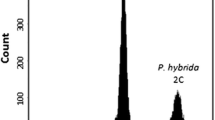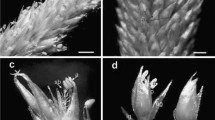Abstract
The development of new approaches to improve breeding efficiency of tropical forage grasses is of great importance. The most recently developed techniques to study the type of apomixis and to establish the modes of reproduction in progeny of apomictic plants i.e.: callose deposition test, clearling methods, intact embryo sac analysis, flow cytometry, molecular approaches and the methods of classiacal light and transmission electron microscopy are described and discussed. Cytological and functional aspects of apospory with following aposporous parthenogenesis, and diplospory in grasses are highlighted.
Similar content being viewed by others
References
Assienan, B. & M. Noirot, 1995. Izozyme polymorphism and organization of the agamic complex of the Maximae (Panicum maximum Jacq., P. infestum Anders, and P. trichocladum K.Schum.) in Tanzania. Theor Appl Genet 91: 672–680.
Bashaw, E.C. & W.W. Hanna, 1990. Apomictic reproduction. In: G. Chapman (Ed.) Reproductive Versatility in the Grasses. Cambridge: Cambridge University Press. pp. 100–130.
Battaglia, E., 1963. Apomixis. In: P. Maheshwary (Ed.), Recent Advances in the Embryology of Angiosperms. pp. 221–264. University of Delhi, India.
Brown, W.H. & W.H.P. Emery, 1958. Apomixis in Gramineae. Tribe Andropogonaceae. Bot Gaz 118: 246–253.
Burson, J.L., 1994. Cytological mechanisms of apospory and diplospory. In: G.S. Khush (Ed.), Apomixis: Exploiting Hybrid Vigor in Rice. pp. 35–38. International Rice Research Institute, Los Banos, Philippines.
Carman, I.G., C. Crane & O. Riera-Lizarazu, 1991. Comparative histology of cell walls during meiotic and apomeiotic megasporogenesis in two hexaploid Australin Elymus species. Crop Sci 31: 1527–1532.
Chao C Y., 1980. Autonomous development of embryo in Paspalum conjugatum. Ber Bot Not 133: 215–222.
Chapman G.P., 1992. Grasses Evolution and Domestication. Cambridge University Press, Cambridge.
Chapman, G.P. & N. Bursi, 1994. Apomixis in Pennisetum: an ultrastructural study. Intern J Plant Sci 155(5): 492–497.
Combes, D., 1975. Polymorphisme et modes de reproduction dans la section des Maximae du genre Panicum Jacq. (Graminees) en Afrique. ORSTOM, p. 77.
Comparative Embryology of Flowering Plants. M.S. Yakovlev (Ed.). 1981, 264 p., 1983, 363 p., 1985, 185p. 1987, 391 p., T.B. Batygina (Ed.) 1990, 332 p. (in Russian).
Embryology of Flowering Plants. Terminology and Concepts 1994. T.B. Batygina (Ed). v.1. Gernerative organs of flower. 508 p. (in Russian).
Golubovskaya I.N., 1989. Meiosis in maize: mei genes and conception of genetic control of meiosis. Adv Genet 26:149–193.
Hall, I.L.& C. Hawes,1991. Electon Microscopy of Plant Cells. Academic Press. INC.
Hayward, M.D., 1995. The EU/STD Programme, ‘The Manipulation of Apomixis for the Improvement of Tropical Forages’. Abstract of International Conference: Harnessing Apomixis: ‘A New Frontier in Plant Science’ Sept.25–27, 1995, College Station, Texas, USA, p.53.
Herr, J.M., 1971. A new clearling-squash technique for the study of ovule development in angiosperms. Am J Bot 58: 785–790.
Hua Yan, Hong Yuan Yang & W.A. Jensen, 1989. An electron microscope study on in vitro parthenogenesis in sunflower. Sex Plant Reprod 2: 154–166.
Johri, B.M., 1984. Embryology of Angiosperms. Spring-Verlag, Berlin.
Jongedijk, E., 1987. A quick enzyme squash technique for detailed studies of female miosis in Solanum. Stain Technol 62: 135–142.
Khush, G.S, D.S. Brar, J. Bennett & S.S. Virmani, 1994. Apomixis for rice improvement. In: G.S. Khush (Ed.), Apomixis: Exploiting Hybrid Vigor in Rice. pp. 1–17. International Rice Research Institute, Los Banos, Philippines.
Kindiger, B. & C. Dewald, 1994. Gernome accumulation in aestern gamagrass, Tripsacum dactyloides (L.) L. (Poaceae). Genetica 92: 197–201.
Kindiger, B., V. Sokolov & C. Dewald, 1996. A comparison of apomictic reproduction in eastern gamagrass (Tripsacum dactyloides (L.) L.) and maize-Tripsacum hybrids. Genetica 97: 103–110.
Kojima, A. & Y. Nagato, 1992a. Diplosporous embryo sac formation and the degree of diplospory in Allium tuberosum. Sex Plant Repr 5: 72–78.
Kojima A. & Y, Nagato, 1992b Pseudogamous embryogenesis and the degree of parthenogenesis in Allium tuberosum. Sex Plant Repr 5: 79–85.
Leblanc, O., M.D. Peel, J.G. Carman & Y. Savidan, 1995. Megasporogenesis and megagametogenesis in several Tripsacum species (Poaceae). Am J Bot 82,1: 37–63.
Leblanc, O., D. Grimanelli & D. Gonzales-de-Leon, 1995. Detection of the apomictic mode of reproduction in maize-Tripsacum hybrids using maize RFLP markers. Theor Appl Genet 90: 1198–1203.
Lubbers, E.L., L. Arthur & W.W. Hanna, 1994. Molecular markers shared by diverse apomictic Pennisetum species. Theor Appl Genet 89: 636–642.
Martinez, E.J., F. Espinoza & C.L. Quarin, 1994. Biii progeny (2n+n) from apomictic Paspalum nodatum obtained through early pollination. J of Heredity 85,4: 295–2977.
Matzk, F., H.-M. Mayer, H. Baumlein, H.-J. Balzer, 1995. A novel approach to the analysis of the initiation of embryo development in Gramineae. Sex Plant Reprod 8: 266–272.
Mazzucato, A., G. Barcaccia, M. Pezzotti, M. Falcinelli, 1995. Biochemical and molecular markers for investigating the mode of reproduction in the facultative apomict Poa pratensis L. Sex Plant Reprod 8: 133–138.
Nagato, Y., 1994. Embryo and flower development in rice and apomixis in Chinese chive (Allium tuberosum) In: G.S. Khush (Ed.), Exploiting Hybrid Vigor in Rice. pp. 43–46. International Rice Research Institute, Los Banos, Philippines.
Nakagawa, H., 1990. Embryo sac analysis and crossing procedure for breeding apomictic guineagrass (Panicum maximum Jacq.). JARQ 24,2: 163–168.
Nakagawa, H. & W.W. Hanna, 1992. Induced sexual tetraploids for breeding guineagrass (Panicum maximum Jacq.)
Naumova, T.N., 1990. Apomixis and amphimixis in angiosperms: Classification. ANL 2: 33–38.
Naumova, T.N., 1991. Apogameti in Trillium camschatcense: Ultrastructural aspects. ANL 3: 16–17.
Naumova, T.N., 1993. Apomixis in Angiosperms: Nucellar and Integumentary Embryony. CRC Press, Boca Raton, 144 p.
Naumova, T., A.P.M. den Nijs & M.T.M. Willemse, 1993. Quantitative analysis of aposporous parthenogenesis in Poa pratensis genotypes. Acta Bot Neerl 42(3): 229–312.
Naumova, T.N., Th.S.M. de Bock & M. Wagenvoort, 1995. Apomixis and sexuality in Brachiaria decumbens accesions. ANL 8: 28–31.
Naumova T.N. & F. Matzk, (in press). Pathenogenesis and sexuality in wheat: Ultrastructural investigation.
Naumova, T.N. & M.T.M. Willemse, 1995. Ultrastructural characterization of apospory in Panicum maximum. Sex Plant Repr 8: 197–204.
Nogler, G.A., 1984. Gametophytic apomixis. In: A.M. Johri (Ed.), Embryology of Angiosperms. Springer-Verlag, Berlin.
Noirot, M., J.L. Messanger, B. Dubos, M. Miquel & O. Lavores, 1986 La production grainière des nouvelles variété de Panicum maximum selectionèes en Cote d'Ivoire. Fourrages, 106: 11
Nybom, H., 1993. Application of DNA fingerprinting in plant population studies. In: DNA fingerprinting: State of the Science (Pena, S.D.J., Chakraborty, R., Epplen, J.I., Jeffrey, S.J. Eds). pp. 293–309. Birkhauser, Basel.
Osadchii, Ja. & T.N. Naumova, 1996. Diplospory in Poa nemoralis and P. palustris: ultrastructural investigation. ANL 9: 6–9. htt: //192.100.189.39 / CImmyT / Biotechnology / apomixis / Newsletter / 9 /ANL 6-9.htm.
Ozias-Akins, P., McNay, J.W., Dujardin, M. & Hanna W.W., 1989. Restriction fragment length polymorphism mapping in apomictic Pennisetum hybrids. J Cell Biochem Suppl, 13: 340.
Pernes, J., Combes, R., Rene-Chaume, R. & Savidan, Y., 1975. Biologie et populations naturelles du Panicum maximum Jacq. Cah. ORSTOM Ser. Biol. 10, 77.
Poddubnaja-Arnoldy, V.A., 1976. Cytoembryology of Angiosperms. Nauka, Moscow (in Russian).
Quarin, C.L. & W.W. Hanna, 1980. Effect of three ploidy levels on meiosis and mode of reproduction in Paspalum hexastachyum. Crop Sci 20: 69.
Quarin, C.L., W.W. Hanna & A. Fernandez, 1982. Genetic studies in diploid and tetraploid Paspalum species. Embryo sac development, chromosome behavior and fertility in P. cromyorrhizon, P. laxum and P. proliferum. J Hered 73: 254.
Quarin, C.L. & G.A. Normann, 1987. Cytology and reproductive behavior of Paspalum equitans, P. ionanthum and their hybrids with diploid and tetraploid cytotypes of P. cromyorrhizon. Bot Gaz 148: 386.
Renno, J.-F., G.H. Schmelzer, & J.H. de Jong, 1995. Variation and geographical distribution of ploidy levels in Pennisetum section Brevival vula (Poaceae) in Burkina Faso, Benin and south Niger. Pl Syst Evol 198: 89–100.
Rodkiewicz, B., 1967. Walls with callose in the megaspores and hypostase of ovules of Antirrhinum majus observed in a fluorescence microscope. Bull Acad Pol 15: 393–495.
Rodkiewicz, B., 1970. Callose in cell wall during megasporogenesis in angiosperms. Planta 93: 39–47.
Rutishauser, A., 1969. Embryologie und Fortpflanzungsbiologie der Angiospermen. Springer, Berlin, Heidelberg, New York.
Savidan, J.H., 1982. Nature et hérédite de l apomixis chez Panicum maximum Jacq. PhD thesis, Travaux et documents de O.R.S.T.O.M., Paris.
Sherwood, R.T., 1995. Nuclear DNA amount during sporogenesis and gametogenesis in sexual and aposporous buffelgrass. Sex. Plant Reprod. 8: 85–90.
Solntzeva, M.P., 1990. Classification of embryo sacs of apomictic plants. ANL 1: 4–6.
Theunis, C.H., E.S. Pierson & M. Cresti, 1991. Isolation of male and female gametes in higher plants. Sex Plant Repr. 4: 145–154.
Van der Maas, H.M., M.A.C.M. Zaal, E.R. de Yong, F.A. Kreus & J.L. van Went, 1993. Isolation of viable egg cells of perennial ryegrass. Protoplasme.
do Valle, C.B., C. Glienke & G.O. Campos, 1994. Inheritance of apomixis in Brachiaria, a tropical forage grass. ANL 7: 42–43.
Vielle, J.-Ph., B.L. Burson, E.C. Bashaw & M.A. Hussey, 1995. Early fertilization events in the sexual and aposporous egg apparatus of Pennisetum ciliare (L.) Link. Plant Journal 8,2: 309–316.
Warmke, H.E., 1954. Apomixis in Panicum maximum. Am J Bot 41: 5–11.
Author information
Authors and Affiliations
Rights and permissions
About this article
Cite this article
Naumova, T.N. Apomixix in tropical fodder crops: cytological and functional aspects. Euphytica 96, 93–99 (1997). https://doi.org/10.1023/A:1002909110354
Issue Date:
DOI: https://doi.org/10.1023/A:1002909110354




